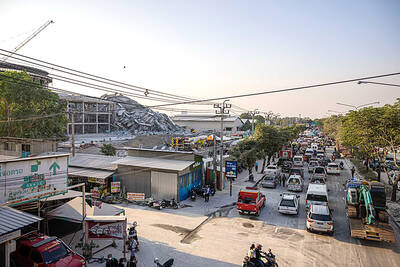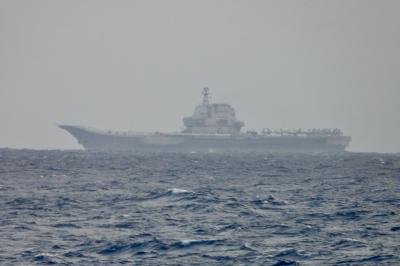A free-trade agreement (FTA) between China and ASEAN came into force yesterday, consolidating a sixfold surge in economic activity over the past decade between countries representing a quarter of the world’s population.
The agreement expands a limited 2005 trade area between China and the 10-member ASEAN, scrapping tariffs on about 90 percent of goods. By 2015, duties must be cut to no more than 50 percent on “highly sensitive” items, including ambulances in Brunei, popcorn in Indonesia, snowboard boots in Thailand and toilet paper in China.
China’s economic clout in Southeast Asian countries has risen over the past decade as policy makers slashed tariffs on electronics, automobile parts and computer chips. Japan, India, Europe and the US have followed China in courting ASEAN, home to investments from Intel Corp, the world’s largest maker of computer chips, and Toyota Motor Corp, the biggest automaker.
“This FTA is going to make a difference at the margin to some ASEAN countries, but not others,” said Razeen Sally, a director of the Brussels-based European Centre for International Political Economy, a trade-policy research group. “Basically, it takes down the tariffs, but does little on all the non-tariff barriers where you would have much bigger gains to trade.”
China’s trade with ASEAN has jumped sixfold since 2000 to US$193 billion last year, surpassing that of the US. China’s share of Southeast Asia’s total commerce has increased to 11.3 percent from 4 percent in that time, whereas the portion of trade the US has with the bloc fell to 10.6 percent from 15 percent, ASEAN statistics show.
During that time, ASEAN’s trade deficit with China widened by five times to US$21.6 billion. The bloc reported a US$21.2 billion trade surplus with the US last year, down 12 percent from 2000.
The trade agreement would hit high-tariff industries in Indonesia and the Philippines more than other ASEAN countries, Sally said.
Trade in parts and components, the “central artery” of China-ASEAN economic ties, won’t be affected much because most of those tariffs are already near zero, he said.
Opposition to the trade agreement has been loudest in Indonesia, where the government has sought to placate concerns that industries, including textiles, food and electronics, will suffer. Indonesia should renegotiate the deal because the textile industry may see its domestic market share decline by 50 percent as cheaper Chinese goods enter the market, said Ade Sudradjat, vice chairman of the Indonesian Textile Association.
The government is setting up a team to monitor trade practices, Hatta Rajasa, coordinating minister for the economy, told reporters in Jakarta on Wednesday.
“When a nation has cheap products, we must see whether there’s unfair trade in it, such as unfair subsidies,” Rajasa said. “We must be proactive.”
Indonesia, ASEAN’s biggest economy and home to about 40 percent of the bloc’s 584 million people, has required Chinese exports of garments, electronics, shoes, toys and food be shipped from designated ports, with every container inspected upon arrival.
China, poised to overtake Germany as the world’s largest exporter this year, faces 101 trade investigations in 19 countries, Xinhua news agency reported last month.
ASEAN governments should resist the temptation to raise non-tariff barriers, the association’s secretary general, Surin Pitsuwan, told Xinhua in an interview published yesterday.
To help its exporters, China has halted the yuan’s gains against the US dollar from July last year. Last year the yuan remained largely unchanged against the US dollar, while Indonesia’s rupiah climbed 15.5 percent, Thailand’s baht advanced 4.2 percent and the Philippine peso increased 2.3 percent.
ASEAN includes Indonesia, Thailand, Malaysia, Singapore, Brunei, the Philippines, Cambodia, Laos, Myanmar and Vietnam. Wide economic disparity has hindered the group’s efforts to form a single market, as the purchasing power of the group’s four richest countries was 10 times greater than that of the other members last year, statistics on the bloc’s Web site show.

AIR SUPPORT: The Ministry of National Defense thanked the US for the delivery, adding that it was an indicator of the White House’s commitment to the Taiwan Relations Act Deputy Minister of National Defense Po Horng-huei (柏鴻輝) and Representative to the US Alexander Yui on Friday attended a delivery ceremony for the first of Taiwan’s long-awaited 66 F-16C/D Block 70 jets at a Lockheed Martin Corp factory in Greenville, South Carolina. “We are so proud to be the global home of the F-16 and to support Taiwan’s air defense capabilities,” US Representative William Timmons wrote on X, alongside a photograph of Taiwanese and US officials at the event. The F-16C/D Block 70 jets Taiwan ordered have the same capabilities as aircraft that had been upgraded to F-16Vs. The batch of Lockheed Martin

GRIDLOCK: The National Fire Agency’s Special Search and Rescue team is on standby to travel to the countries to help out with the rescue effort A powerful earthquake rocked Myanmar and neighboring Thailand yesterday, killing at least three people in Bangkok and burying dozens when a high-rise building under construction collapsed. Footage shared on social media from Myanmar’s second-largest city showed widespread destruction, raising fears that many were trapped under the rubble or killed. The magnitude 7.7 earthquake, with an epicenter near Mandalay in Myanmar, struck at midday and was followed by a strong magnitude 6.4 aftershock. The extent of death, injury and destruction — especially in Myanmar, which is embroiled in a civil war and where information is tightly controlled at the best of times —

China's military today said it began joint army, navy and rocket force exercises around Taiwan to "serve as a stern warning and powerful deterrent against Taiwanese independence," calling President William Lai (賴清德) a "parasite." The exercises come after Lai called Beijing a "foreign hostile force" last month. More than 10 Chinese military ships approached close to Taiwan's 24 nautical mile (44.4km) contiguous zone this morning and Taiwan sent its own warships to respond, two senior Taiwanese officials said. Taiwan has not yet detected any live fire by the Chinese military so far, one of the officials said. The drills took place after US Secretary

THUGGISH BEHAVIOR: Encouraging people to report independence supporters is another intimidation tactic that threatens cross-strait peace, the state department said China setting up an online system for reporting “Taiwanese independence” advocates is an “irresponsible and reprehensible” act, a US government spokesperson said on Friday. “China’s call for private individuals to report on alleged ‘persecution or suppression’ by supposed ‘Taiwan independence henchmen and accomplices’ is irresponsible and reprehensible,” an unnamed US Department of State spokesperson told the Central News Agency in an e-mail. The move is part of Beijing’s “intimidation campaign” against Taiwan and its supporters, and is “threatening free speech around the world, destabilizing the Indo-Pacific region, and deliberately eroding the cross-strait status quo,” the spokesperson said. The Chinese Communist Party’s “threats